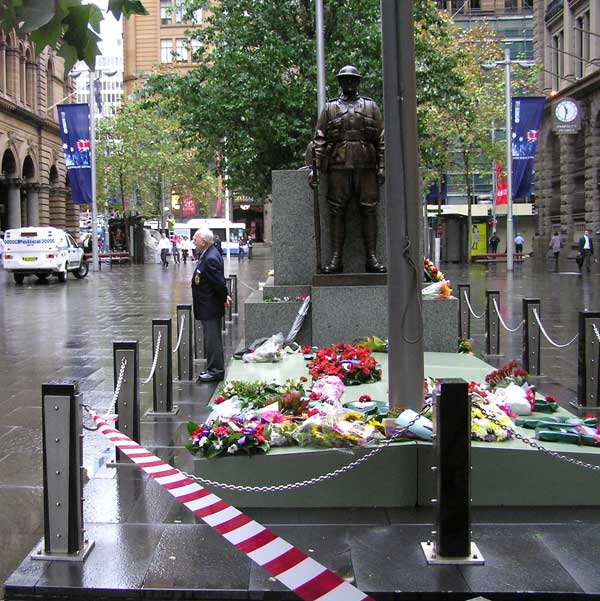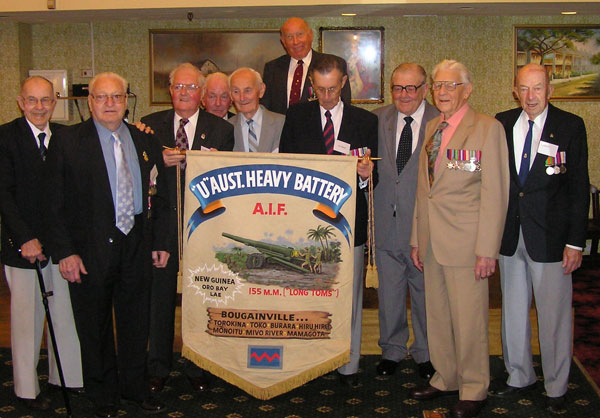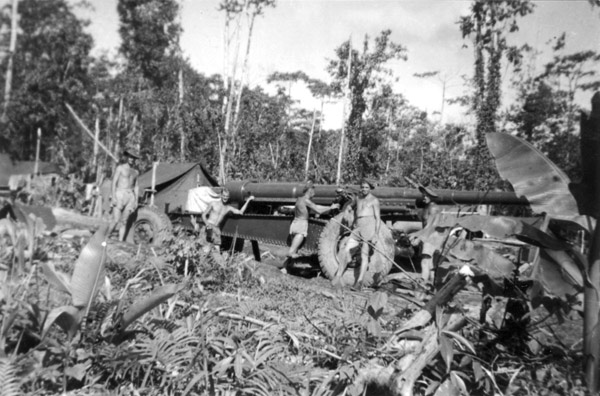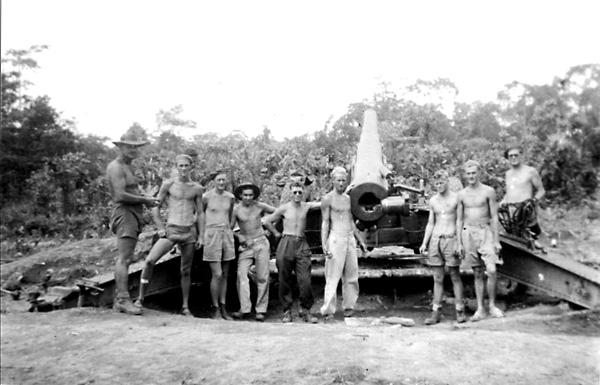The ‘U’ Bty Association at its Reunion Luncheon in 2007 gifted their Banner to Royal Australian Artillery National Museum.
‘U’ Battery’s banner has been paraded for more than 59 years, its origins now forgotten, as it always appeared for the important occasions for the ex-members of the battery. As their numbers are declining the committee and members gifted the Banner to the RAA National Museum, North Fort, for safekeeping and preservation.
The Banner Preservation Project is a scheme that is jointly fostered by the RAA Historical Company, RAA Association (NSW) Inc and the Army History Unit (North Fort) and aims to acquire through deed of gift the Banners that have been used by artillery associations. Gunfire has reported on the initial workshop with WW2 and post-WW2 associations and the handover of the Queensland WW1 Artillery Banner by the Gunner Signallers’ Club.

In response to representations by Colonel Commandant Eastern Region, COL Allan Piercy and his predecessor, Don Tait, now President of the RAA Association (NSW), the ‘U’ Battery Association Committee commenced clarification of the opportunity to place their banner into safekeeping. These negotiations were conducted with the curator of the RAA National Museum who provides the administration and services to the project.
Having received assurances of the ongoing access to the banner the committee recommended the course of action to their members and organised for the handover to coincide with their 2007 wreath laying ceremony and reunion luncheon on April 24.
At 1130hrs the members of the Association and guests met near the GPO, taking shelter from the threatening rain under its thoughtfully provided colonnade. Master of Ceremonies was Mr. Jack ‘Bluey’ Mercer, Hon Secretary of the ‘U’ Bty Association.
Emerging from the portico of the GPO Building they formed up on Mr Reg Gilbert as marker and under the control of Mr John Stevenson, ‘U’ Bty President, they marched to the Cenotaph where John placed their wreath in memory of those who served.
Members then made their way up Martin Place to the Commercial Travellers Club (CTA) where the guests and member’s family members chatted while the Association conducted a short AGM following which all moved to the dining room for a splendid lunch.
Mr John Stevenson, ‘U’ Bty Association President, proposed the Loyal Toast. ‘Bluey’ outlined the history behind the decision to gift the banner to the RAA National Museum. The Hon Secretary, ‘Bluey’ Mercer, proposed a toast to ‘Invited Guests’ to which the Colonel Commandant Eastern Region, COL Allan Piercy, replied highlighting the appropriateness of preserving the history of Anzac Day marches and not allowing these banners to be lost as have most of the WW1 Association Banners.
Mr Jim Stuart, Hon Treasurer, proposed a toast to the Ladies and Visitors and in response Mrs Phil Hoenger, wife of Mr Rudolph Hoenger replied noting that her connection with the personnel and later the battery went back some 66 years to Jervis Bay. She paid a brief tribute to those young gunners, men who formed ‘U’ Hvy Bty.
Keith Schwalbach toasted the committee for their work in progressing the issue. Later, in talking with him he revealed that the banner’s splendid attendance record at all major events was nearly ruined in 2002.
Returning from ‘U’ Bty’s annual reunion on the eve of Anzac Day, Keith suffered his fourth stroke, blacking out for a short time on his way back home in the train. He was furious with himself for the bad timing and perplexed as to how the banner might get to the march.
Well you have heard of RMOs who occasionally could be found occupying the layers seat, but in Keith’s case it was his GP who came to his aid. With his surgery located at Wilberforce and living in Parramatta, Dr Azmir volunteered to take the banner to Mr Wally McKee’s home at Dundas. Knocking off at 6pm, he delivered the banner, ringing back to Keith’s wife to complete the job so that his patient could “rest easy”. Interviewed by a local paper, Dr Azmir said “it was nothing”.
However to Keith it was really something. “Doctors prescribe medicine from a bottle,” he said, “but this was medicine of another form. Not many doctors would take the time to do something special like that.”
As a result the banner was paraded and Keith did not have to face the orderly room to explain why it was AWOL.
Following luncheon, ‘Bluey’ formally handed over the banner to Warrant Officer Class 2, Peter Armstrong, Curator, RAA National Museum, North Fort. In addition the Battery Association presented a cheque to the Museum to assist with preservation of the banner.
Good to his word, Peter not only accepted both the banner and the cheque, but then made it available to the Association so that it could be marched on Anzac Day. During the lunch word had come through that Reg Gilbert’s son was flying into Sydney for Anzac Day, specifically to carry the banner for any who were able to march.
For more than 59 years, the banner has been a rallying point replacing the unit’s colours that were placed into maintenance and repatriated to Australia in 1945, never to be fired again. No wonder the current custodians of the banner become emotional when they talk of it. It represents the battery, its men and their exploits.
It is now 62 years since the cessation of hostilities with Japan. The ‘U’ Bty Association was formed and has paraded their banner in Anzac marches in memory of those who lost their life during the conflict and departed comrades. Today the Association numbers approximately 20 members and like many WW2 Associations is passing on its memories and memorabilia to the “keepers of the history”.
The battery members in the 2007 photograph are (L-R) Cec Wallace, Rudolph Hoenger, Roy Wheeldon, Athol Webster, Allan Dundon, Keith Schwalbach, and the members of the current association committee, Jim Stuart, (Treasurer); John Stevenson, (President); Jack ‘Bluey’ Mercer (Secretary) and Les Green.
Battery History
The Battery was assembled at Breakwater Battery in Wollongong during Sep 1943 by the Deputy Fire Commander, Kembla Fortress, MAJ GC Christie who became the initial BC with CAPT RA Hitchens as BK. 12 ORs from the Newcastle Fortress brought the Battery up to establishment.
Initial 155mm gun and equipment training was conducted at Fort Lytton by attachment to 1 Aust Hvy Trg Bty. A section was trained in the Sperry CASL equipment and additional instruction included Bofors AA, Stokes Mortar, grenades, small arms and automatic weapons.
By early December the Battery was on its way north to Magazine Battery Townsville for further intensive training, including sub-calibre coastal shoots. The Battery was classified as an AIF unit 10 Dec 1943.
By February 1944 training in using the 155mm gun in a field role had commenced. This training culminated in immediate neutralisation and destruction shoots at a range of 10,000 yards.
On 19 Apr the Battery embarked on HMT Katoomba and sailed for Buna via Milne Bay, New Guinea. During the voyage personnel manned lookouts and assisted naval gunners with manning the ship’s armament consisting of 1*4 inch, 1* 12 pdr, 2 Oerlikons, 2 Colt 0.50 inch and 4 Vickers guns.
By Anzac Day 1944 they had relieved ‘F’ Aust Hvy Bty at Oro Bay until ordered to move to Lae at the end of August.
During September the battery recommenced training in the field role in addition to the coast role and CAPT Hitchens became acting BC and CAPT JI McKenna was attached as a supernumerary as well as a number of NCOs from 2/11 Fd Regt to provide training assistance.
CAPT JI McKenna administered command from 12 December, acting on a secret warning order to move to Bougainville Island under command 2 Aust Corps on arrival. Strength increased by transfers in from 2/11 Fd Regt and 31 Hvy AA Bty. The battery was to take 6 guns of which two were to be kept as spares. ‘U’ Hvy Bty in this configuration was double the size of the other ‘Letter’ batteries.
Equipment, transport and stores were loaded onto George Peat, a converted vehicular ferry at Lae and arrived at Cape Torokina, Jan 16 1945, unloading at a pontoon wharf. CAPT Hitchens returned from leave and CAPT JI McKenna was attached to 4 Fd Regt as an FOO for a period.
Four guns were moved to a position for a practice shoot but had some difficulty with felling trees to provide crest clearance. 4 Fd Regt provided an explosives party that cleared the required trees. Meanwhile observation parties developed panoramas at the Torokina OP position. On Jan 29 the four guns fired a total of 96 rounds and personnel were involved in close protection training and small arms qualifications.
During March a recce of gun sites in the Toko area was undertaken by CAPT JI McKenna. Advanced party moved by land ahead of the guns. 4 * 155mm “Long Tom” were deployed by LST. Heavy wind and rain delayed the deployment but four targets were registered on Apr 11.
Apr 17, 120 rounds fired in support of an infantry attack on Hatai and Hongarie Roads. April saw the battery move into a gun position previously occupied by 5 Bty 2 Aust Fd Regt and the preparation of a new position while registering targets by ARTY/R (artillery reconnaissance). May saw the battery move to a new position and release gun tractors. From their new position they engaged probable hostile battery. CAPT JI McKenna appointed BC and promoted T/MAJ.
On 24 May the battery engaged and destroyed an enemy bunker detected by Air OP. By the end of May a new position had been recced and enemy ground parties were becoming more active.
[During the Sydney Luncheon, I discussed with Rudolph Hoenger (who was a Sgt with ‘U’ Bty) the task of moving a battery of 155 guns with Matador tractors through 25-30,000 m of jungle on jeep tracks.
Rudolph recalled that route preparation was by night using borrowed American dozers with full headlight illumination.
Before daybreak they dug a trench with the dozer then parked it across the trench to provide protection and a chance to sleep while waiting for night to press on. Vic Rae]
In early June the guns were calibrated and survey by firing tasks were commenced.
In late June the battery was engaging hostile batteries and area targets in which enemy troops were concentrated. A party preparing a new position were engaged by hostile 150mm and 75mm artillery. Many of these counter bombardment tasks were based on the analysis of earlier reports from listening posts and predicted fire when they again became active. (Horner p. 405)
The battery fired further survey missions during July and counter bombardment with a confirmed 75mm gun destroyed on Jul 6.
Increased en ground activity set off booby traps during darkness July – August. On 16 Aug, RAA 3 Aust Div advised that hostilities with Japan had ceased. All gun ammunition was returned to depot on 12 Sep and guns were prepared for storage.
Some members marched out to 2 Aust Mountain Battery as part of BCOF. From Oct to Dec small groups of high priority discharge moved out of the battery and the remaining members embarked on the Taroona for Townsville arriving at Chermside, Brisbane Dec 17. While no disbandment date is recorded in published records or the War Diary, MAJ JI McKenna was BC on Dec 31 1945 when the final stores were returned to depot.
In summary, the Battery fired 2578 rounds. It was the only ‘Letter’ Battery to convert to a total field role, delivering the equivalent of about 9,800 25 pdr rounds. The battery had its share of frustrations, cracked trails, deploying a heavy gun along corduroy jeep tracks, shortages of hydraulic oil for the recoil system, damage to firing tubes and the problem of man handling and the storage of heavy ammunition in humid conditions.
With the passage of time, the identities of the gunners in this 1945 photograph are no longer certain.
The capacity to fire concentrate heavier fire over longer ranges than field guns was a lesson aptly demonstrated on Bougainville. Late WW2 experience appeared to favour a regiment consisting of a battery of 155 guns and a second battery of 155 howitzers. The same thinking underpins the decision to move from 105mm to 155mm ordnance in the current concepts for today’s army.
Of the original members of ‘U’ Bty, CAPT Roy Hitchens joined the CMF, was promoted to MAJ and commanded 113 Coast Artillery Battery. He became a member of the Newcastle Branch of the RAA Association (NSW) and served on the branch committee and as Treasurer. The late, LT NF Rosen, joined the RAA Association (NSW) in 1955 and became a Life Member 24/7/62. Jack ‘Bluey’ Mercer currently the Hon Secretary of the ‘U’ Bty Association joined RAA Association (NSW) Inc in 2006.
The 24 April 2007 marks the occasion when the ‘U’ Aust Heavy Battery Association Banner was handed over to the RAA National Museum for safe-keeping and preservation. This is a joint project between the Army History Unit, North Fort; the RAA Historical Company and the RAA Association (NSW) Inc to foster and maintain the Association banners and to display them with the assistance of serving gunners at appropriate times and occasions.
Ref: Kidd R and Neal R; The ‘Letter’ Batteries, the history of the ‘letter’ batteries in World War II; 1998
Horner, D; The Gunners; A History of Australian Artillery, 1995
Dexter, D; The New Guinea Offensives; 1968
Australian War Memorial Databases.






